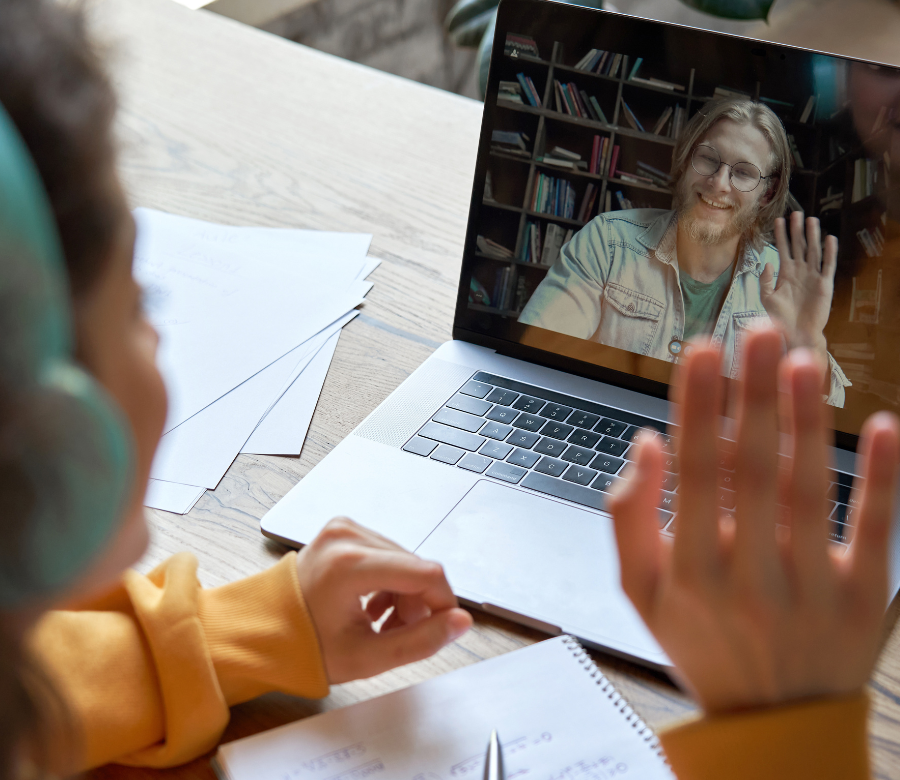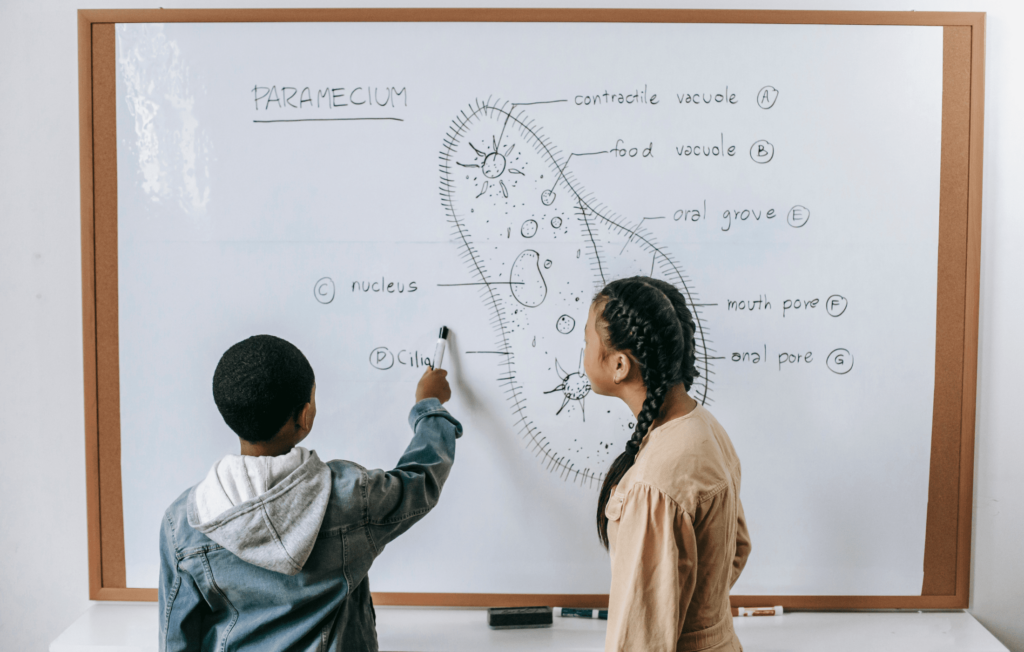If you’re looking for a way to spend meaningful time with your elementary school-aged children in an excellent online learning environment that challenges and encourages thoughtful academics, play, and resilience, elementary education at VLACS may be the answer you’ve been looking for. Read on.
3 Online Elementary Education Myths, Debunked
Myth 1: Kids in online elementary school sit in front of a computer all day.
False. Michelle Wahl, VLACS Kindergarten teacher with two decades of classroom experience, explains that elementary school students at VLACS spend an average of three to four hours per day total interacting with the online material — and that includes “practice.”
“Practice” could look like tracing the letters of the alphabet, using a number line constructed from a clothesline, or playing with dice. For younger children, it looks like play. For older elementary-aged children, it feels a bit more like studying, says VLACS 5th grade teacher Kaitlin Duke.
“It’s not just reading and re-reading the materials in the modules,” she says. “It’s reading it a few times, sure. But then it’s students explaining what they learned to someone at home, or doing a quick internet search project to learn more about something, or applying what they’ve learned in a meaningful way.”
Myth 2: Kids in online elementary school don’t interact with their peers.
False. Since kids aren’t in front of screens all day, they have time to do other things. Wahl says that parents can offer opportunities for their kids to socialize through sports, the arts, music, community events, and neighborhood playdates. She adds, “kids can do school around life events, too,” like soccer games and concerts.
Duke’s students love the weekly activity sessions at VLACS in addition to the weekly meetings. These sessions “bring same-age kids together in a teacher-facilitated activity. The kids love getting to see each other and practice communication in a fun environment,” says Duke. “I also encourage parents to look into local community-based programs.”
Duke explains that the traditional 15-minute recess and maybe 30-minute lunch at most schools is the only unstructured peer time that kids have at school. “At VLACS,” she says, “there are many more opportunities for social interaction.”
Myth 3: Kids in online elementary school fall behind and can’t catch up.
False. If they follow the recommended pace chart, attend their weekly meetings, follow the guidance of their instructors, and have reliable help at home, they won’t fall behind at all.
Wahl explains, “Kids don’t fall behind because they actually have the ability to pace their work and spend more time in areas they need support, and then less time in areas they have already mastered. The self-pacing and ability to really dig into a concept offers a more solid foundation.”
Duke explains that parents play a critical role in that foundation, “The sooner we get parents involved and explain their role as facilitators and coach them through it, the more successful they — the parents and the kids — are.”
It’s not only an investment in your child, she explains, but “it’s this whole new relationship that parents get to have with their kids. Parents get to be with their kids and guide their learning.”
That means working closely with their VLACS instructors to create routines that work for kids and their parents.
Wahl tells the story of a few kindergarten families who struggled at the beginning of last school year, who were worried that their children wouldn’t be ready for first grade the following year, that 100% remote elementary school wouldn’t work.
“I worked with the families all year,” she explains. “The kids, of course, but I really spent a lot of time with the parents and they said, ‘Oh, it was so hard at first, I didn’t get it, but we persevered, we understand how this works now.'” She pauses. “They all signed up for first grade — and they’re excited.”
What Online Elementary School Looks Like at VLACS
It likely looks different than what you’re used to seeing. It’s hands-on. It’s immersive. It’s intense. It’s fun. It meets kids where they are — and allows them to flourish at their own pace. You take an active role.
At VLACS, elementary school is as much an opportunity for kids as it is for their parents and caregivers.
Wahl, who not only taught Kindergarten at VLACS but also had her own kids in the first-grade program, explains, “Routine is critical.”
She says that “most days, 8 am-12 pm, we did VLACS.” But some days, she says, “We didn’t. We did other things to support our learning.” She also says that she worked with other families who needed a different schedule than the one she had created at home for her children. “VLACS allows families to embrace that flexibility,” she says.
In upper elementary grades, the model is similar. Duke explains, “In the 4th and 5th grades, content is high level. You’re not teaching your students how to learn as much as you’re teaching them content.”
She stresses to families the importance of a schedule and works with them to create the best one possible that facilitates learning. It starts with the weekly meeting — not just for Duke, either. Wahl, and every other elementary instructor at VLACS, meet weekly with their students and their families to develop those schedules and routines, make the expectations clear, and customize the experience.
Duke explains that sometimes families “rush through and their kid doesn’t do well.”
That’s when the weekly meeting comes in handy. She reviews the pace chart with parents and redirects the conversation. “A lot of families expect to do a lesson per day per subject, which is the brick and mortar model that they’re used to,” she says. “I help them reframe their expectations and give them the scope of the week. They really shouldn’t be doing more than 3 lessons per subject per week in elementary school, even in 5th grade.”
Once those routines and expectations are established the magic happens.” VLACS,” says Duke, “gives families the opportunity to let their children dive into concepts instead of simply being swept along by the current. The kids who gravitate toward a certain skill set can accelerate their achievement.”
Jo Strong, VLACS’s Elementary School Program Manager reflects on the new programs for both part-time and full-time elementary students. “Our elementary instructors have learned how to be coaches. They’ve learned how-to guide, how to facilitate. They use their expertise to guide parents on what the child needs for success.”
She explains, “Kids need executive functioning skills. They need to learn how to learn. We help teach them how to do that. We give them the content. We give them the framework. We support the parents. We give what we can so that they can do their best.”
Ready for your next move? If you think VLACS’s elementary education programs might be a good fit or you have questions about the program, drop us a line here or register for an upcoming open house here.




